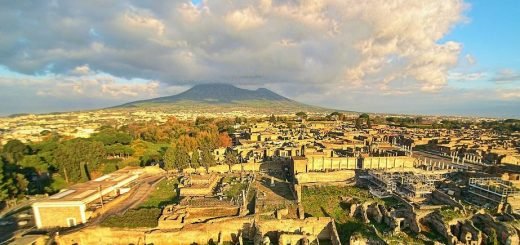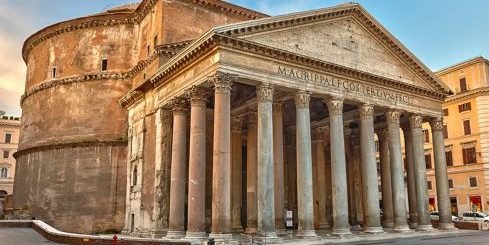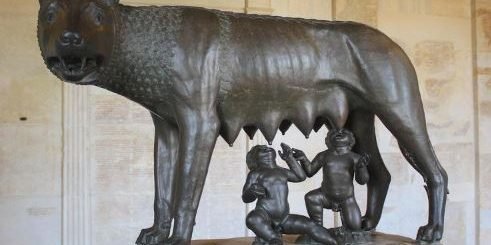What survived the eruption of Mount Vesuvius in Pompeii?
The eruption of Mount Vesuvius in 79 AD preserved Pompeii in a unique way, encapsulating the city beneath layers of ash and pumice.
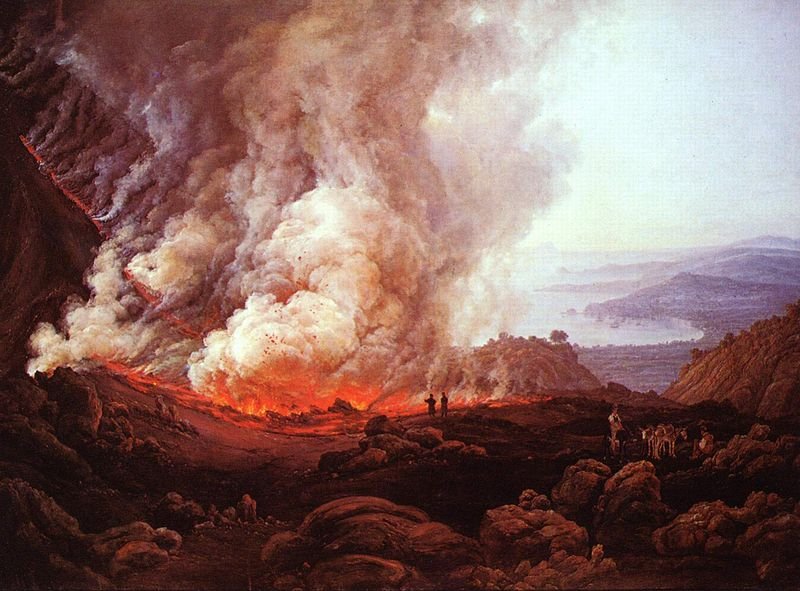
The eruption of Mount Vesuvius in 79 AD is the most famous eruption, which led to the destruction of Pompeii, Herculaneum, and other surrounding settlements. Image: Eruption of Vesuvius, 1826 painting by Danish-Norwegian artist I.C. Dahl
This tragic event paradoxically ensured that much of the city’s structure, artifacts, and even some organic materials remained intact, offering a remarkable window into Roman daily life.
Here’s what survived:
Architecture
Many buildings, from homes to temples to bathhouses, were preserved to varying degrees. Some still had intact roofs, while others retained only their foundational structures.
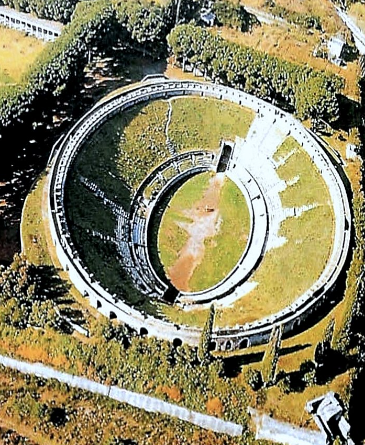
Amphitheatre of the ancient city of Pompeii
Wall Paintings and Frescoes
Pompeii is renowned for its frescoes. Many walls in the homes of the affluent displayed intricate and colorful frescoes depicting mythological scenes, daily life, and other themes.
Mosaics
Numerous intricate floor mosaics, often made with tiny colored tiles, survived. Some are remarkably detailed and provide insight into art, culture, and daily activities.
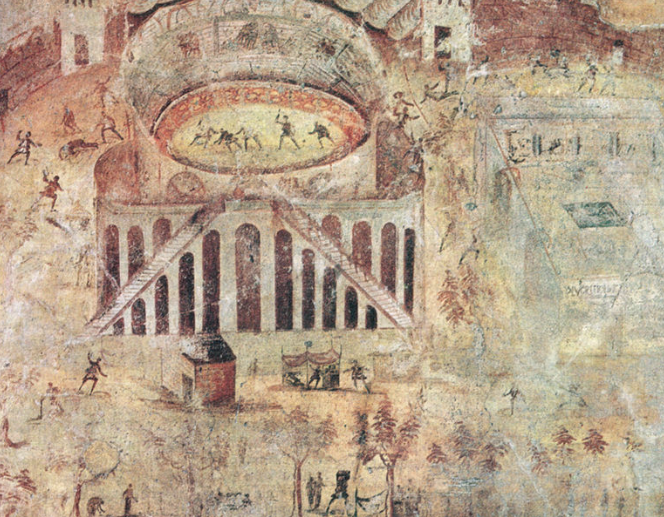
Fresco depicting the fight in the amphitheatre between Pompeians and Nucerians
Artifacts
A wide range of everyday objects were found, including pottery, tools, jewelry, kitchen utensils, furniture, and more. These items give a comprehensive view of daily Roman life, from the mundane to the luxurious.
Casts of People and Animals
One of the most poignant aspects of the Pompeii excavations is the plaster casts of people and animals. These were made by pouring plaster into voids left in the hardened ash, which were originally the decomposed bodies of those who perished. The casts capture the final moments of residents, showing their positions and expressions when the disaster struck.
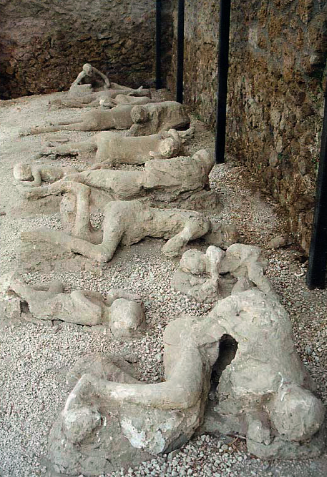
For example, located in what is now the Garden of the Fugitives – an archeological site in Pompeii – archeologist Amedeo Maiuri uncovered in 1961 the holow cavities of 13 victims of the eruption of Mount Vesuvius. Scientists then filled the cavities with plaster, thereby revealing the bodies of the victims.
Graffiti
Scribblings on the walls, from political endorsements to declarations of love, have given researchers insights into the concerns and preoccupations of Pompeii’s citizens.
Gardens
Impressions of plants in the ash layers, as well as paintings, have allowed archaeologists to reconstruct gardens and even identify specific plants cultivated in Pompeii.
Bakeries, Shops, and Taverns
Many commercial establishments were preserved, complete with equipment like ovens and grinding stones. They offer a view of commerce and daily transactions in the city.
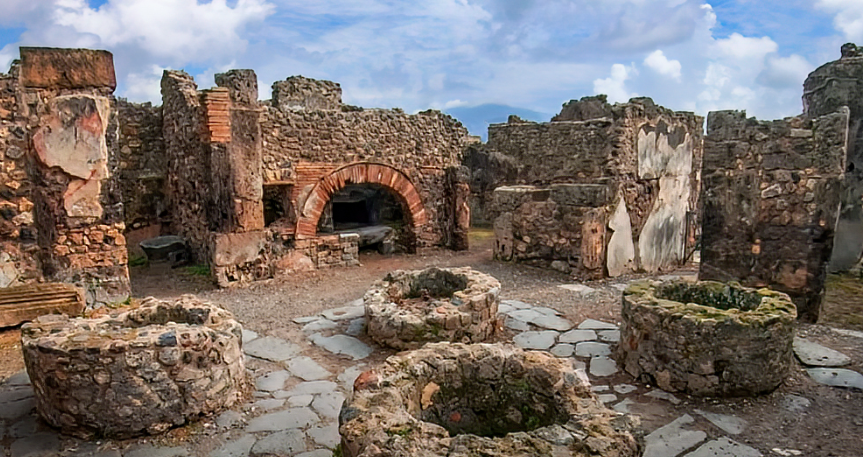
Bakery in Region VIII in Pompeii
Bodies
Some organic materials, like wooden objects and even foodstuff, were carbonized by the intense heat of the pyroclastic flows and ash. While these didn’t “survive” in their original form, their carbonized remnants provide vital information.
Infrastructure
Elements of the city’s infrastructure, like lead pipes used for plumbing, stone-paved streets with pedestrian crossings, and even deep ruts in roads from cart traffic, survived and have been uncovered.
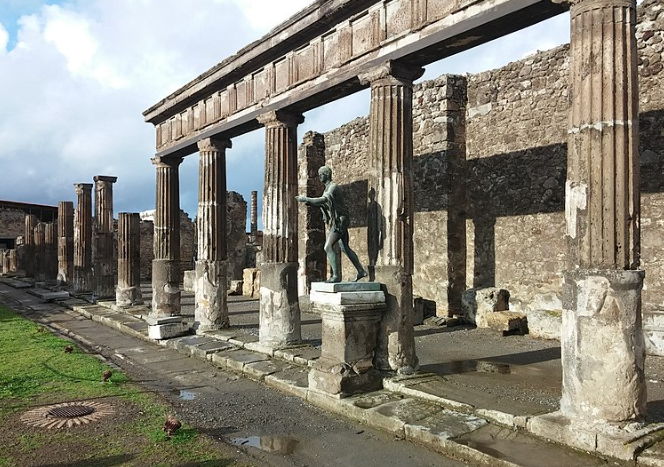
The preservation of Pompeii offers a rare, detailed look at a city from antiquity, frozen in time. The archaeological site continues to be a source of study, revealing more about the Roman world with each excavation.
Why was the site of Pompeii preserved?
The reason why the site remained so well-preserved over centuries is explained by a combination of natural elements. After the ash from the volcanic eruption settled on the city, rain followed. This rain mixed with the ash to create a muddy substance.
Because of the specific composition of this mud, which can be likened to epoxy (a type of adhesive), it solidified and hardened over time. This solidified mud acted as a sealant, effectively encapsulating and protecting the city and its contents.
This natural sealing process preserved structures, objects, and even the impressions of bodies, giving future generations a detailed and tangible snapshot of the city and its inhabitants at the time of the catastrophe.
Comparisons to an atomic bomb
The eruption propelled a mixture of super-heated tephra (rock fragments and particles ejected by an eruption) and gases. This combination is particularly deadly, as the tephra can bury and burn while the gases can asphyxiate.
The volcanic column reached an astonishing altitude of 33 km (21 miles). This height is significant as it means the eruption was so powerful that it sent materials into the stratosphere, affecting weather patterns and having potential global consequences.
The volcano ejected materials at an astounding rate of 1.5 million tons per second. This highlights the sheer volume and speed at which the destructive materials were released.
The eruption’s thermal energy is compared to the atomic bombings of Hiroshima and Nagasaki, two of the most devastating events in recent history. By stating that Vesuvius released 100,000 times the thermal energy, the text emphasizes the incomprehensible power and scale of the natural disaster.
How the eruption provided a unique window into Roman life
In the 18th century, when excavations began, archaeologists found entire buildings, frescoes, artifacts, and even casts of people, capturing a moment in time. The sites have since offered unparalleled insights into the daily life, art, and culture of the Roman world.

Fresco of Roman deity Bacchus and ancient Greek deity Agathodaemon with Mount Vesuvius, as seen in Pompeii’s House of the Centenary
In summary, the eruption of Mount Vesuvius in 79 AD led to the tragic but historically informative preservation of Pompeii and Herculaneum, providing modern civilization with a detailed snapshot of Roman life.
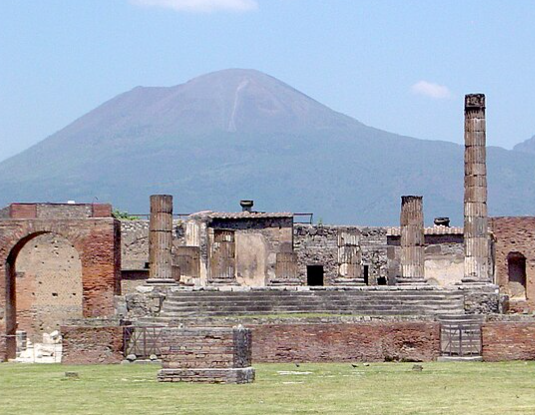
Pompeii, a UNESCO World Heritage Site, stands as one of Italy’s top tourist destinations, drawing more than 2 million visitors each year.
Response of Emperor Titus to the Eruption of Mount Vesuvius in 79 AD
Emperor Titus took immediate action to help the affected areas. He appointed two ex-consuls to oversee and manage the relief efforts. In ancient Rome, consuls were among the highest-ranking officials, so appointing ex-consuls suggests he entrusted this critical task to experienced and capable hands.
Titus went beyond just appointing leaders; he delved into the imperial treasury, generously donating substantial sums to help the victims.
It’s also been stated that the emperor personally visited Pompeii, one of the cities most affected by the eruption, not just once but twice. His first visit was shortly after the eruption to witness the immediate aftermath and possibly to better understand the needs of the people. The second visit the following year might have been to monitor the progress of the recovery efforts.
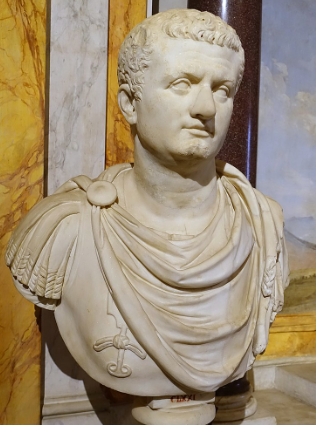
The second ruler to hail from the Flavian dynasty, Titus was emperor from 79 to 81 AD. When Mount Vesuvius erupted in August 79 AD, the emperor did not remain distant from the tragedy.
Facts about the eruption of Mount Vesuvius in 79 AD
In 79 AD, one of the most infamous volcanic eruptions in history took place when Mount Vesuvius erupted. Here’s what you need to know:
- Mount Vesuvius: Located on the western coast of Italy, Mount Vesuvius is one of the continent’s most well-known volcanoes, largely because of its eruption in 79 AD.
- Eruption: In August of that year, Vesuvius violently erupted. The eruption was sudden and catastrophic, catching the inhabitants of nearby cities by surprise.
- Location of Pompeii: This Roman city was located near the base of the volcano. As Vesuvius erupted, it spewed a massive amount of pumice, hot ash, and volcanic gases into the atmosphere. The heavy fall of this material, which amounted to 4–6 meters in depth, buried Pompeii completely. As a result, many of the city’s structures, as well as its residents, were preserved underneath this thick layer. Over time, this covering layer solidified and essentially “froze” the city in time, preserving buildings, artifacts, and even the forms of people in the exact positions they were in at the time of death.
- Residents’ reaction: Evidence suggests a range of responses: some sought shelter in their homes or public buildings, others tried to flee the city, and many were overtaken by the ash and gases quickly.
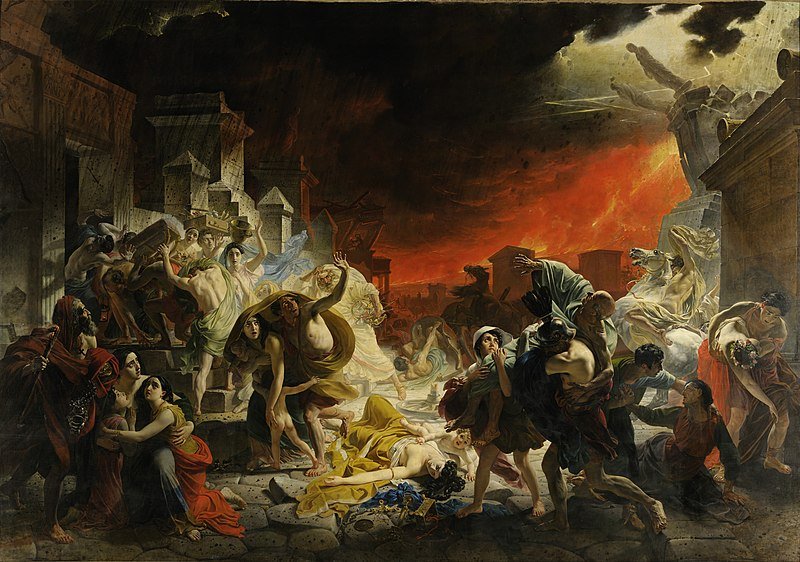
Pompeii was buried under 4-6 meters of volcanic ash and pumice when Mount Vesuvius erupted in 79 AD. The human cost of the eruption was tragic. It’s believed that over a thousand individuals perished due to the eruption. However, the precise number of casualties remains uncertain and could be higher. Image: The Last Day of Pompeii. Painting by Russian painter Karl Brullov, 1830–1833
- Death toll: The city had a population of approximately 10,000 people at the time of the eruption. From this number, a massive proportion—around 8,000 individuals—lost their lives due to the eruption. Only about 1,500 managed to survive the initial eruption. The death toll was particularly high because there were not one but two major eruptions. The second eruption was even more powerful and devastating than the first, killing many of those who might have initially survived.
- Herculaneum: A bit closer to the volcano than Pompeii, the town of Herculaneum was also affected by the eruption, but in a slightly different way. While Pompeii was buried in pumice and ash, Herculaneum was engulfed by pyroclastic flows—fast-moving currents of hot gas and volcanic matter. These flows were so hot and rapid that they carbonized organic material, including wooden structures and human bodies. Similar to Pompeii, the town was buried and preserved under a dense layer of material.
- Documentation: The eruption is famously documented by Gaius Plinius Caecilius Secundus (also known as Pliny the Younger) in two letters to the Roman historian Tacitus. He described the event in detail as he witnessed it from a distance and through the accounts of his uncle, Pliny the Elder, who died during a rescue mission.
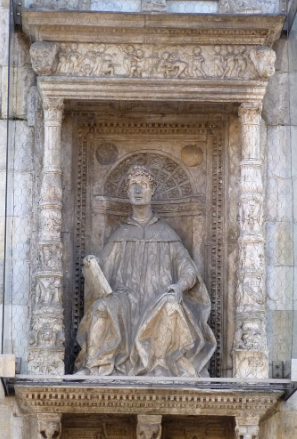
The details of 79 AD eruption were documented by Pliny the Younger in letters to the Roman historian Tacitus. Image: Statue of Pliny the Younger on the facade of Cathedral of S. Maria Maggiore in Como, Italy.
Questions and Answers about Pompeii and the eruption of Mount Vesuvius
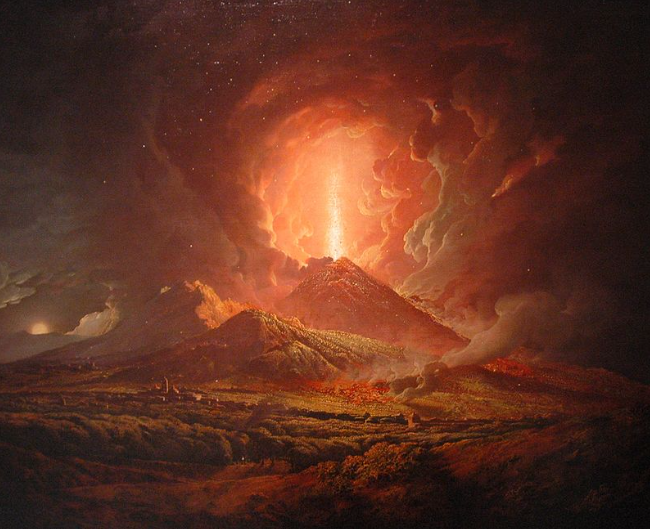
An astonishing rate of volcanic material was ejected, with molten rock and pulverized pumice being expelled at a rate of 6×10^5 cubic meters per second. This equates to an enormous 7.8×10^5 cubic yards per second. Image: An eruption of Vesuvius seen from Portici, by English portrait painter Joseph Wright (c. 1774–6)
Here are some common questions about Pompeii:
Where is Pompeii located?
Pompeii is located near the modern city of Naples in the Campania region of Italy.
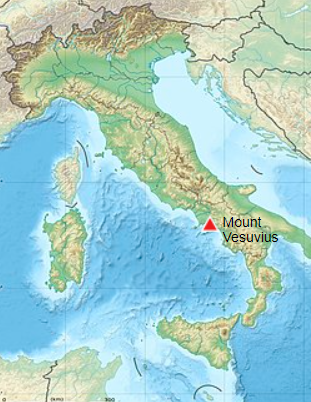
Location of Mount Vesuvius in modern-day Campania, Italy
Who was the Roman emperor at the time?
Titus (reign: 24 June 79 – 13 September 81) – oldest son and successor of Emperor Vespasian – was the Roman emperor at the time of the eruption. The eruption took place a few months after his ascension to the throne.
Why is Pompeii significant?
The volcanic ash that covered Pompeii acted as a preservative, freezing the city in time and offering a unique snapshot of daily life in an ancient Roman city.
When was Pompeii rediscovered?
The site was rediscovered in 1748 by the Spanish military engineer Roque Joaquín de Alcubierre (1702 – 1780).
How were the body outlines of Pompeii’s victims created?
The decaying bodies left voids in the hardened ash. In the 19th century, archaeologist Giuseppe Fiorelli devised a technique to pour plaster into these voids, creating detailed casts that captured the final moments of the victims.
Are there other cities that were affected by the 79 AD eruption of Vesuvius?
Yes, Herculaneum is another city that was buried and preserved by the eruption, though it was engulfed by pyroclastic flows rather than ash. The eruption is said to have occurred over two days on August 24 and 25.
Other Roman cities destroyed by the eruption include Oplontis and Stabiae.
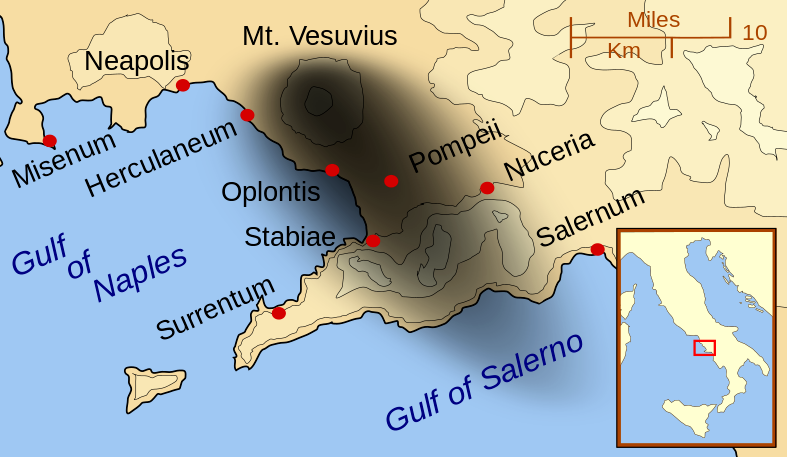
The eruption most notably affected the Roman cities of Pompeii and Herculaneum, but also had an impact on other smaller settlements and villas in the surrounding region.
What do the excavations of Pompeii tell us about Roman life?
They provide insights into daily activities, architecture, diet, commerce, art, and various aspects of social and personal life in ancient Rome.
Is it possible to visit Pompeii today?
Yes, Pompeii is a major tourist attraction and UNESCO World Heritage site. Visitors can walk through the streets of the ancient city and explore many of its buildings and homes.
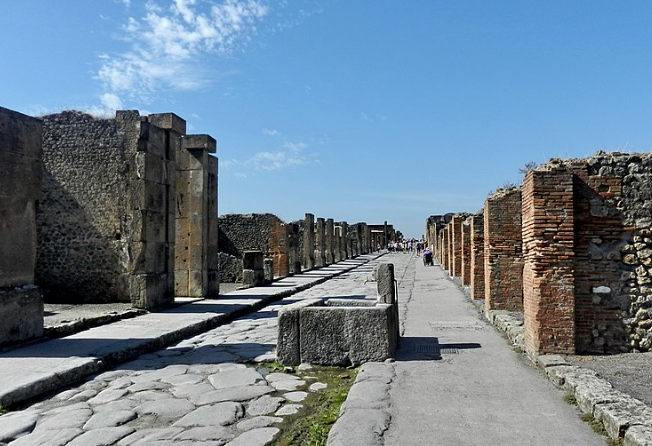
Via dell’Abbondanza, the main street in ancient Pompeii
What dangers does Mount Vesuvius pose today?
Mount Vesuvius is still an active volcano. While it’s closely monitored, there’s potential for future eruptions that could affect nearby modern settlements.
How much of Pompeii has been excavated?
About two-thirds of the 66-hectare (165-acre) ancient city has been excavated. The remaining area is left untouched for future generations of archaeologists and with improved techniques and technologies.
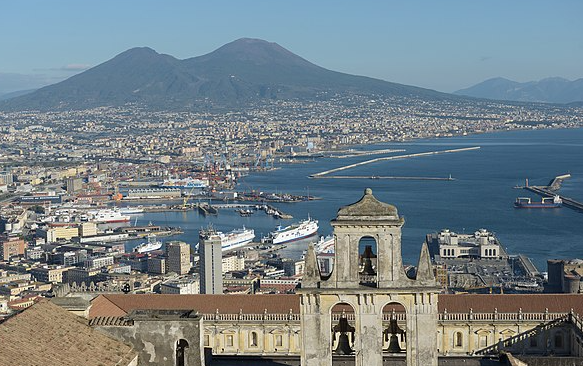
Vesuvius poses a significant threat to the modern cities and towns that surround it, with several million people living in the potential danger zone. Efforts are ongoing to ensure preparedness in the event of another eruption.
Other times that Mount Vesuvius erupted
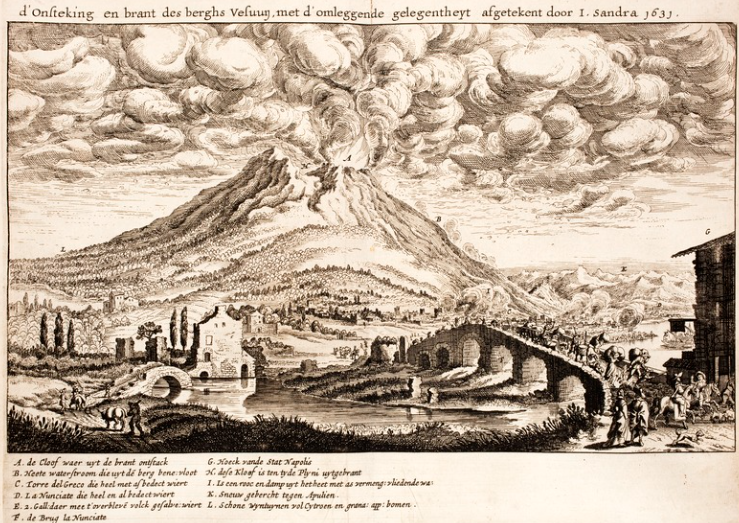
The 79 AD eruption was immensely powerful, with a volcanic column reaching a staggering height of 33 km (about 21 miles). This column comprised not just smoke, but also stones, ashes, and various volcanic gases. Image: Eruption of 16 December 1631. Joachim von Sandrart and Matthias Merian in Danckerts Historis, 1642.
Mount Vesuvius is one of the world’s most dangerous volcanoes due to its explosive nature and proximity to densely populated areas. It has erupted multiple times throughout history.
Aside from the year 79 AD, here are some other notable eruptions:
- 172: Another significant eruption occurred, which was noted by the ancient historian Cassius Dio.
- 203: An eruption is recorded to have occurred around this time.
- 472: An eruption so massive that it reportedly spread ash as far as Constantinople (modern-day Istanbul).
- 512: Another eruption that caused damage to the nearby town of Naples.
- 1631: After almost 1,100 years of dormancy, Vesuvius erupted again, killing around 3,000 people. This eruption marked the beginning of the volcano’s modern eruptive phase.
- Multiple eruptions between 1631 and 1944: Vesuvius became an active volcano with multiple eruptions occurring over these years. Some significant eruptions in this period occurred in 1660, 1682, 1694, 1698, 1707, 1737, 1760, 1767, 1779, 1794, 1822, 1834, 1839, 1850, 1855, 1861, 1868, 1872, 1906, 1926, 1929, and 1944.
- 1944: This is the most recent major eruption of Vesuvius, which led to the destruction of several villages. It also caused damage to the nearby Allied airfields during World War II.
Currently, Mount Vesuvius is closely monitored for any signs of activity, as it remains a significant threat to the millions of residents in the nearby city of Naples and its surrounding areas.

Whenever Vesuvius erupts it often produces powerful Plinian eruption, characterized by a tall, mushroom-shaped column of ash and pumice that can reach several miles into the atmosphere. Image: The March 1944 eruption of Vesuvius, by Jack Reinhardt, B-24 tail gunner in the USAAF during World War II
